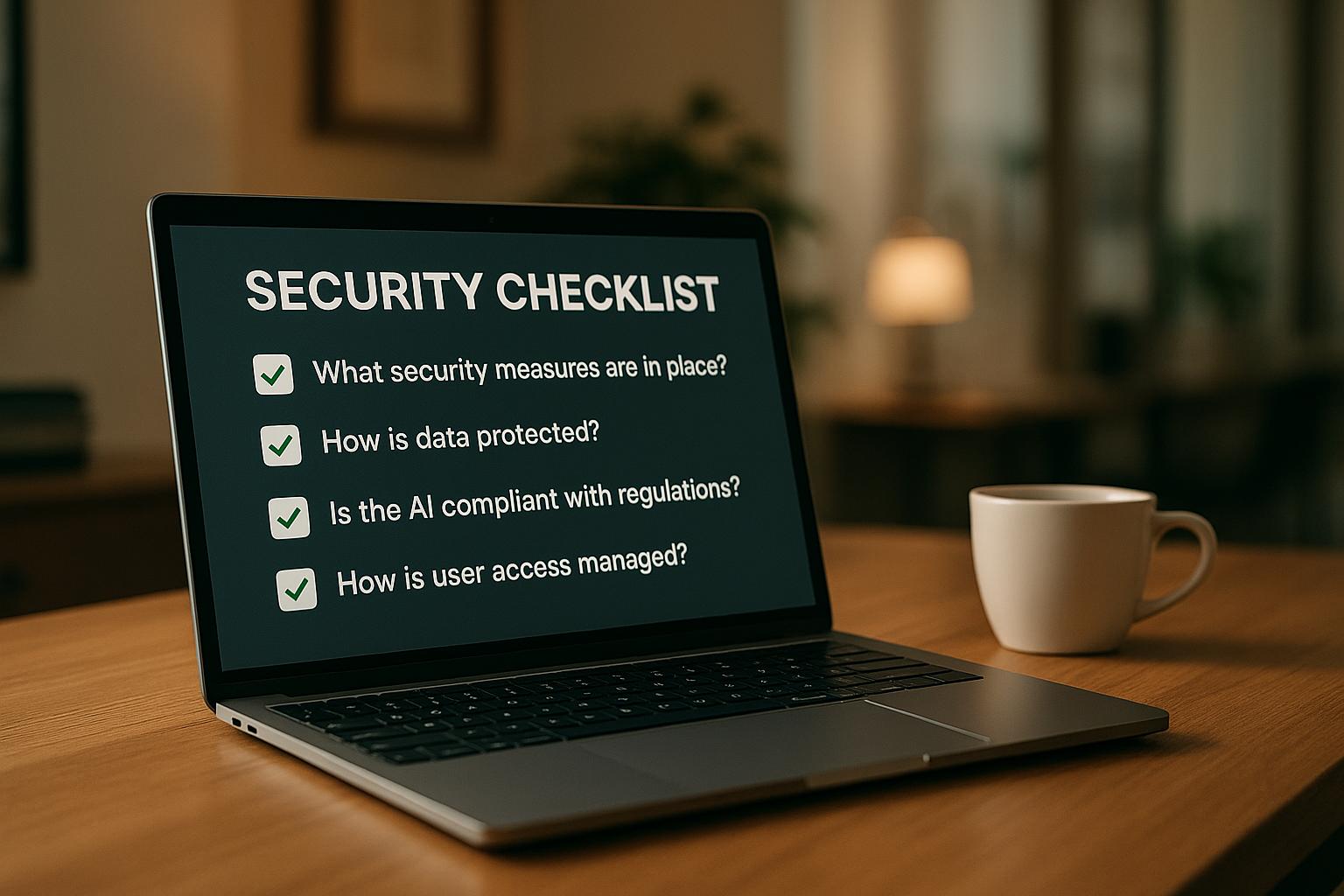- What It Solves: Traditional feedback systems are slow, generic, and struggle with analyzing large data. AI fixes these by providing instant, tailored feedback and actionable insights.
- Key Benefits:
- Immediate Feedback: Delivered when it matters most.
- Data-Driven Analysis: Tracks trends, skill gaps, and performance metrics.
- Personalized Guidance: Tailored to individual roles and goals.
- Consistent Monitoring: Continuous tracking of progress and achievements.
- AI Features:
- Automated feedback delivery (e.g., Mesh.ai increased feedback exchanges by 138%).
- Performance analytics to detect trends and risks.
- NLP tools for sentiment analysis and summarizing feedback.
- Machine learning for predicting performance patterns and challenges.
- Tools to Consider:
- Mesh.ai: Real-time analytics, 15% more top performers.
- LivePerson: Cuts review time by 50-75%.
- Engagedly: Combines 360 feedback with social recognition.
- 15Five: Tracks goals and improves retention.
AI feedback platforms are reshaping workplaces by improving engagement, boosting performance, and enabling smarter decision-making. Ready to explore the future of feedback? Let’s dive in.
Revolutionize Employee Feedback with AI-powered Pulse Surveys
AI Features in Real-Time Feedback Platforms
Automated Feedback Delivery
AI has changed how organizations handle feedback, making it faster and more consistent. Platforms like Mesh.ai use AI-driven reminders to prompt feedback right after important events, such as project completions or meetings. This approach has led to a 138% increase in feedback exchanges, showing how automation boosts engagement [2].
In addition to speed, AI provides valuable insights into performance, helping teams make smarter, data-based decisions.
Performance Analytics
AI tools take raw performance data and turn it into useful insights that businesses can act on. These platforms use advanced analytics to uncover trends, identify areas for improvement, and predict future challenges. Here’s how they make an impact:
| Feature | Purpose |
|---|---|
| Trend Analysis | Monitors performance patterns over time |
| Skill Gap Detection | Identifies where skills are lacking |
| Progress Tracking | Compares progress to set goals |
| Predictive Insights | Flags potential performance risks early |
For example, 15Five connects feedback trends to relevant training resources, making it easier to focus on employee development [2]. This ensures feedback isn’t just given - it’s meaningful and supports growth.
Tailored Feedback
Personalized feedback is one of AI’s strongest capabilities, helping employees grow in ways that match their unique goals and roles. Engagedly uses AI to align feedback with individual objectives and skill sets [2].
This customization takes into account factors like past performance, job responsibilities, and career aspirations. Genpact’s Amber, for instance, delivers instant, actionable feedback by analyzing real-time data [1]. This kind of tailored approach ensures feedback feels relevant and actionable for every team member.
AI Technologies in Feedback Platforms
Natural Language Processing
Natural Language Processing (NLP) plays a key role in modern feedback platforms, allowing them to process and interpret written communication on a large scale. It helps analyze feedback for sentiment, urgency, and key themes, making it easier for managers to respond to concerns by organizing feedback into categories such as employee satisfaction or productivity issues.
A great example is LivePerson's Feedback Assist, which uses NLP to automatically analyze and summarize feedback. It identifies critical patterns and flags important points that need managerial attention, saving time and improving focus [1].
Predictive Insights with Machine Learning
NLP helps understand feedback, but machine learning takes it a step further by predicting trends and potential challenges. By analyzing past feedback, these systems uncover patterns that guide better decision-making.
Mesh.ai showcases how machine learning can make a difference in several areas:
| ML Feature | Impact on Business |
|---|---|
| Recognizing Performance Patterns | Highlights behaviors of top performers |
| Identifying Risks | Detects potential turnover risks early |
| Tracking Development | Monitors progress in skill-building |
| Predicting Goal Success | Estimates the likelihood of hitting targets |
To make the most of these predictions, integrating machine learning tools with existing systems is crucial.
Integration with Other Tools
AI feedback platforms are most effective when they connect seamlessly with existing HR and business systems. Using secure APIs, these platforms enable smooth data sharing, creating a centralized hub for performance management. This makes decision-making easier and streamlines workflows.
In industries like retail and hospitality, where turnover is often high, these integrated systems are especially useful. They provide early warnings about employee satisfaction issues, allowing businesses to act quickly and improve retention. By combining data from multiple sources, these platforms help companies make informed, data-driven decisions.
sbb-itb-bec6a7e
Practical Uses and Business Advantages
Examples of Successful Use
AI platforms like LivePerson and Mesh.ai have delivered measurable improvements in workplaces. For instance, LivePerson has reduced review cycles by up to 75%, while Mesh.ai has increased feedback frequency by 138%. Mesh.ai also boosted high-performer density by 15% and cut review cycles by 60%. These examples highlight how AI-powered feedback systems can streamline processes and enhance performance across various industries.
Industry-Specific Applications
In healthcare, AI feedback tools help maintain patient care standards by providing real-time monitoring and tracking compliance. In retail, they improve service quality and ensure consistency across multiple locations. Meanwhile, tech companies use them to refine team workflows and allocate resources more efficiently. These varied applications underscore the importance of choosing tools that align with specific industry needs, which specialized platforms can simplify.
AI for Businesses as a Resource
For businesses looking to replicate these successes, AI for Businesses serves as a helpful directory for finding the right feedback tools. It offers curated solutions tailored to specific challenges, making it easier for SMEs and growing companies to adopt AI systems that fit their needs and budgets. With this resource, businesses can explore options ranging from simple setups to enterprise-level systems that evolve alongside their growth.
Selecting an AI Feedback Tool
Factors to Consider
Picking the right AI feedback tool can make a big difference in how businesses gather and use feedback to boost engagement and improve performance. Here are some key things to look for when evaluating these platforms.
Integration with existing systems is a must. The platform should work seamlessly with HR systems to avoid manual data entry and ensure accurate reporting. Ease of use is equally important - an intuitive design encourages adoption by both managers and employees. For example, Engagedly combines 360-degree feedback with social recognition, making it a user-friendly option [2].
Scalability is vital for companies expecting growth. As your organization expands, the tool should handle increasing data and users without compromising performance. Data privacy and security are non-negotiable. The platform must comply with regulations and protect sensitive employee data [1].
With these factors in mind, let’s take a closer look at how some popular AI feedback tools stack up.
Comparison of Tools
| Tool | Key Features | Performance Metrics | Best Suited For |
|---|---|---|---|
| Mesh AI | Real-time feedback, Analytics | 138% increase in feedback, 15% rise in high-performer density | Large enterprises |
| LivePerson | Automated summaries, Feedback tools | 50-75% reduction in review time | Mid to large organizations |
| Engagedly | 360 feedback, Social recognition | Improved user engagement rates | Small to medium businesses |
| 15Five | Goal tracking, Performance metrics | Better employee retention | Growing companies |
| PerformYard | Customizable review cycles | Flexible pricing options | Budget-conscious organizations |
Cost is often a deciding factor. PerformYard, for instance, offers flexible pricing, making it a good option for businesses looking to balance affordability with functionality [2]. When evaluating costs, consider not just the upfront investment but also long-term maintenance and the potential return on investment from better performance.
For those needing guidance, AI for Businesses is a helpful resource. Their curated directory includes everything from basic feedback tools to full-scale performance management systems tailored to various operational needs.
Finally, don’t overlook training. Managers need to know how to interpret AI-driven insights and take meaningful action. The best platforms provide thorough onboarding and ongoing support, ensuring businesses make the most of the tool’s capabilities.
Conclusion and Future Trends
Key Benefits Recap
AI-powered feedback platforms have made it easier for organizations to enhance engagement, boost performance, and improve efficiency. These tools process large amounts of data to uncover patterns and trends, enabling managers to make smarter decisions about employee growth and performance management [4]. While these advantages are already reshaping workplaces, new developments are set to push real-time feedback systems even further.
Future of AI Feedback Tools
As technology progresses, organizations stand to gain even more from the next generation of AI-driven feedback systems. AI-powered coaching is now offering personalized growth plans that cater to individual learning preferences [3]. Additionally, integrations are evolving to create unified systems that link feedback, goal-setting, and learning management [2].
In the coming years, AI feedback tools are expected to advance in several areas, including:
- Sentiment and Context Analysis: Using advanced natural language processing to better understand employee feedback.
- Performance Prediction: Leveraging machine learning to forecast trends in employee performance.
- Automated Development Plans: Creating tailored growth strategies based on unique feedback patterns.
The challenge will be to strike the right balance between automation and human involvement. By maintaining this balance, organizations can ensure that AI-driven feedback remains reliable and fair, fostering continuous learning and development [3].


